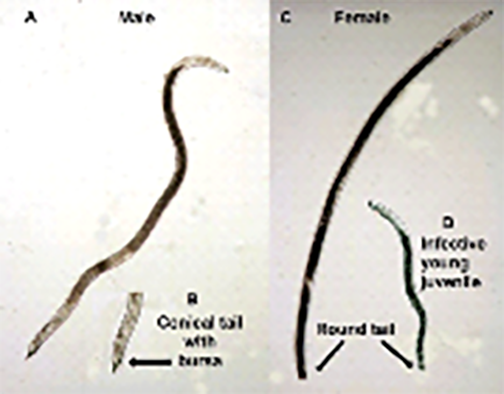Hoplolaimus spp.
Importance:
Plant-parasitic nematodes belonging to the genus Hoplolaimus are commonly called lance nematodes. These nematodes are primarily migratory ectoparasites meaning they feed externally on the roots. Lance nematodes are known to cause damage to a wide variety of field crops (cotton, soybean, corn, peanuts etc.), fruit trees (apples, citrus, peaches, mango, bananas etc.), vegetables (Peas, cabbage, sweet potatoes, etc.), and many ornamentals and turf grasses. While there are over 29 species of lance nematodes distributed worldwide, the two species Hoplolaimus columbus and Hoplolaimus galeatus are considered economically important pests in Georgia, USA.
Description:
Lance nematode (Hoplolaimus spp) adults are vermiform approximately 0.95mm to 1.80mm long with large and thick bodies, distinct head with heavily sclerotized cephalic framework, and a strong stylet with anchor-shaped basal bulbs. They possess a bi-lobed esophagus that overlaps the intestine both dorsally and ventrally. Additionally, the gender of the lance nematode can be determined by the shape of its posterior region. Male tails are conical in shape and covered with the bursa which serves as a protective layer to the spicule but is mainly used for grasping the female during copulation (Photo 1A, 1B), whereas female tails are noticeably short and round with the vulva located near the midbody (Photo 1C).

Lance nematode male (A) tail with bursa (B), female (C) and infective juvenile (D)
Biology:
Life Cycle: The life cycle of lance nematodes consists of four larval stages with four molts that occur during development from egg to adult stages. As males of lance nematodes are rare in some species, their females often undergo parthenogenesis to sustain the population. Mature females lay over 100 eggs individually. The first juvenile stage is completed within the egg but the second, third and fourth juvenile and adult stages are completed outside the eggs. Except for the first juvenile stage, all juvenile and adult stages are considered infective stages (Photo 1A, C, and D). The egg-to-egg life cycle is generally completed within 30 days depending on the soil type and temperature. High population growth occurs between late spring to mid-summer in sandy-loam soil when temperatures range between 80oF/26oC and 85oF/29oC.
Distribution:
Among the 29 species of lance nematodes distributed worldwide, H. columbus and H. galeatus are known to be distributed throughout Georgia and predominantly associated with field crops (cotton, soybean, and corn) and grasses, respectively. According to the Extension Nematode Diagnostic Laboratory, Department of Plant Pathology, University of Georgia, Athens 2023 database, H. columbus and H. galeatus were distributed in 21 and 31 counties, respectively, across Georgia. Recently, the occurrence of H. stephanus infecting creeping bentgrass has also been reported in Georgia (Jagdale et al., 2022).
Damage:
Lance nematodes exhibit both migratory endo- and ecto- parasitism. When in juvenile stages, they are considered migratory endoparasites as they can feed internally on the content of cortical cells and migrate out of the cortical tissue as mature stages. As ectoparasites, they insert stylets into roots, feeding the content of epidermal cells. As endoparasites, lance nematodes puncture entry holes in the roots, migrate through the cortical tissue and feed on the cytoplasm of cortical cells. Consequently, the feeding injuries caused by these nematodes can diminish water and nutrient uptake by roots. Also, the wounds caused during external or internal feeding make roots vulnerable to invasion by disease-causing pathogens like fungi and bacteria. Hoplolaimus galeatus is pathogenic to various species of grasses while H. columbus is known to cause acute damage to three major field crops, including cotton, soybean, and corn. In addition to heavily affecting agriculture production, H. columbus also play a pivotal role in the decline of healthy native pines (Loblolly, Long Leaf and Slash) which are major keystone species found in Georgia. The above ground symptoms include yellowing, stunting, reduced vigor and thinning of turf whereas below ground symptoms include shallow roots with missing feeder roots and root necrosis (Photo 2).

Undamaged and damaged bentgrass roots by lance nematodes
Management:
Lance nematodes are known to be one of the most resistant nematode species to nematicides when considering control methods. As alternative methods, it has been found that having a proper irrigation system, and deep watering the plants can create deeper, stronger root systems that will be less susceptible to damage by lance nematodes. Additionally, rotating resistant, tolerant, or non-host crops can be an effective strategy for nematode management, including lance nematodes. For example, peanuts, identified as a non-host crop for H. columbus, have been demonstrated to be effective in suppressing nematode populations when rotated with other susceptible crops (Thiessen et al., 2020). For current resistant variety and cropping sequence recommendations, contact the respective County Extension offices to learn more information on the best mitigation practices against lance nematodes.
Literature:
Jagdale, G.B., Nugraha, G.T., Martin, K., Martinez-espinoza, A.D. Hajihassani, A. 2022. Occurrence of the lance nematode Hoplolaimus stephanus infecting bentgrass Agrostis stolonifera in Georgia, USA. Plant Health Progress 23, 162- 165.
Thiessen, L., Rosado Rivera, Y. 2020. “Lance Nematode of Soybean – Soybean Disease Information”. NC State Extension Publications. https://content.ces.ncsu.edu/lance-nematode-of-soybean.
Emily Scott & Ganpati Jagdale, Nematology & Pathology, University of Georgia, 2024